將每個級別映射到色輪上均勻間隔的色調。它不會生成colour-blind安全調色板。
用法
scale_colour_hue(
...,
h = c(0, 360) + 15,
c = 100,
l = 65,
h.start = 0,
direction = 1,
na.value = "grey50",
aesthetics = "colour"
)
scale_fill_hue(
...,
h = c(0, 360) + 15,
c = 100,
l = 65,
h.start = 0,
direction = 1,
na.value = "grey50",
aesthetics = "fill"
)參數
- ...
-
參數傳遞給
discrete_scalepalette-
調色板函數,當使用單個整數參數(比例中的級別數)調用時,返回它們應采用的值(例如
scales::hue_pal())。 breaks-
之一:
limits-
之一:
-
NULL使用默認比例值 -
定義可能的比例值及其順序的字符向量
-
接受現有(自動)值並返回新值的函數。還接受 rlang lambda 函數表示法。
-
drop-
是否應該從量表中省略未使用的因子水平?默認值
TRUE使用數據中出現的級別;FALSE使用因子中的所有級別。 na.translate-
與連續尺度不同,離散尺度可以輕鬆顯示缺失值,並且默認情況下會這樣做。如果要從離散尺度中刪除缺失值,請指定
na.translate = FALSE。 scale_name-
應用於與該比例關聯的錯誤消息的比例名稱。
name-
秤的名稱。用作軸或圖例標題。如果
waiver()(默認值),則比例名稱取自用於該美學的第一個映射。如果是NULL,則圖例標題將被省略。 labels-
之一:
guide-
用於創建指南或其名稱的函數。有關詳細信息,請參閱
guides()。 expand-
對於位置刻度,範圍擴展常量的向量,用於在數據周圍添加一些填充,以確保它們放置在距軸一定距離的位置。使用便捷函數
expansion()生成expand參數的值。默認情況下,對於連續變量,每側擴展 5%,對於離散變量,每側擴展 0.6 個單位。 position-
對於位置刻度,軸的位置。
left或right表示 y 軸,top或bottom表示 x 軸。 super-
用於構造比例的超類
- h
-
要使用的色調範圍,在 [0, 360] 中
- c
-
色度(顏色的強度),最大值根據色調和亮度的組合而變化。
- l
-
亮度(亮度),單位為 [0, 100]
- h.start
-
色調開始於
- direction
-
繞色輪移動的方向,1 = 順時針,-1 = 逆時針
- na.value
-
用於缺失值的顏色
- aesthetics
-
字符串或字符串向量,列出了該比例所使用的美學名稱。例如,這可以用於通過
aesthetics = c("colour", "fill")同時將顏色設置應用於colour和fill美學。
例子
# \donttest{
set.seed(596)
dsamp <- diamonds[sample(nrow(diamonds), 1000), ]
(d <- ggplot(dsamp, aes(carat, price)) + geom_point(aes(colour = clarity)))
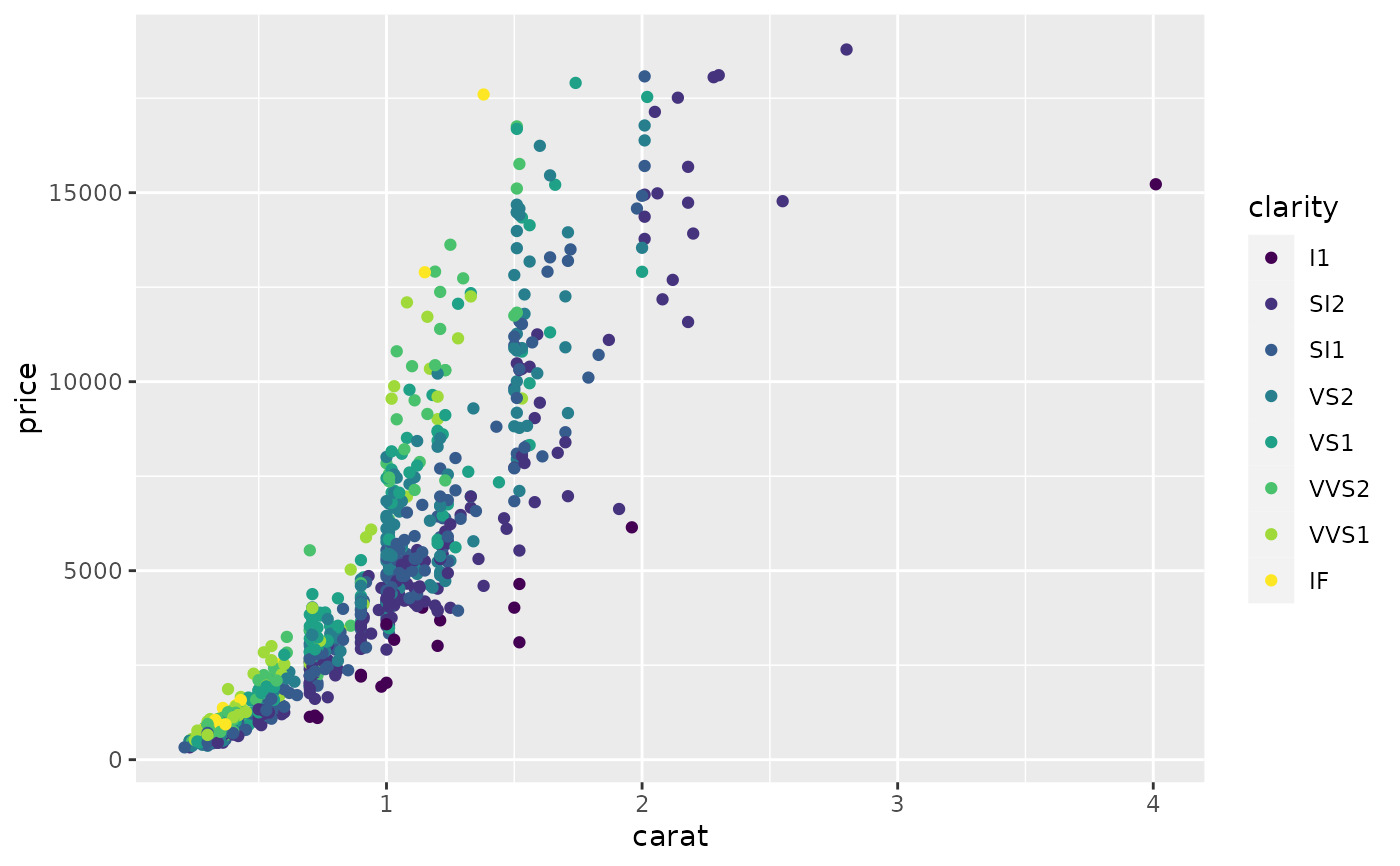 # Change scale label
d + scale_colour_hue()
# Change scale label
d + scale_colour_hue()
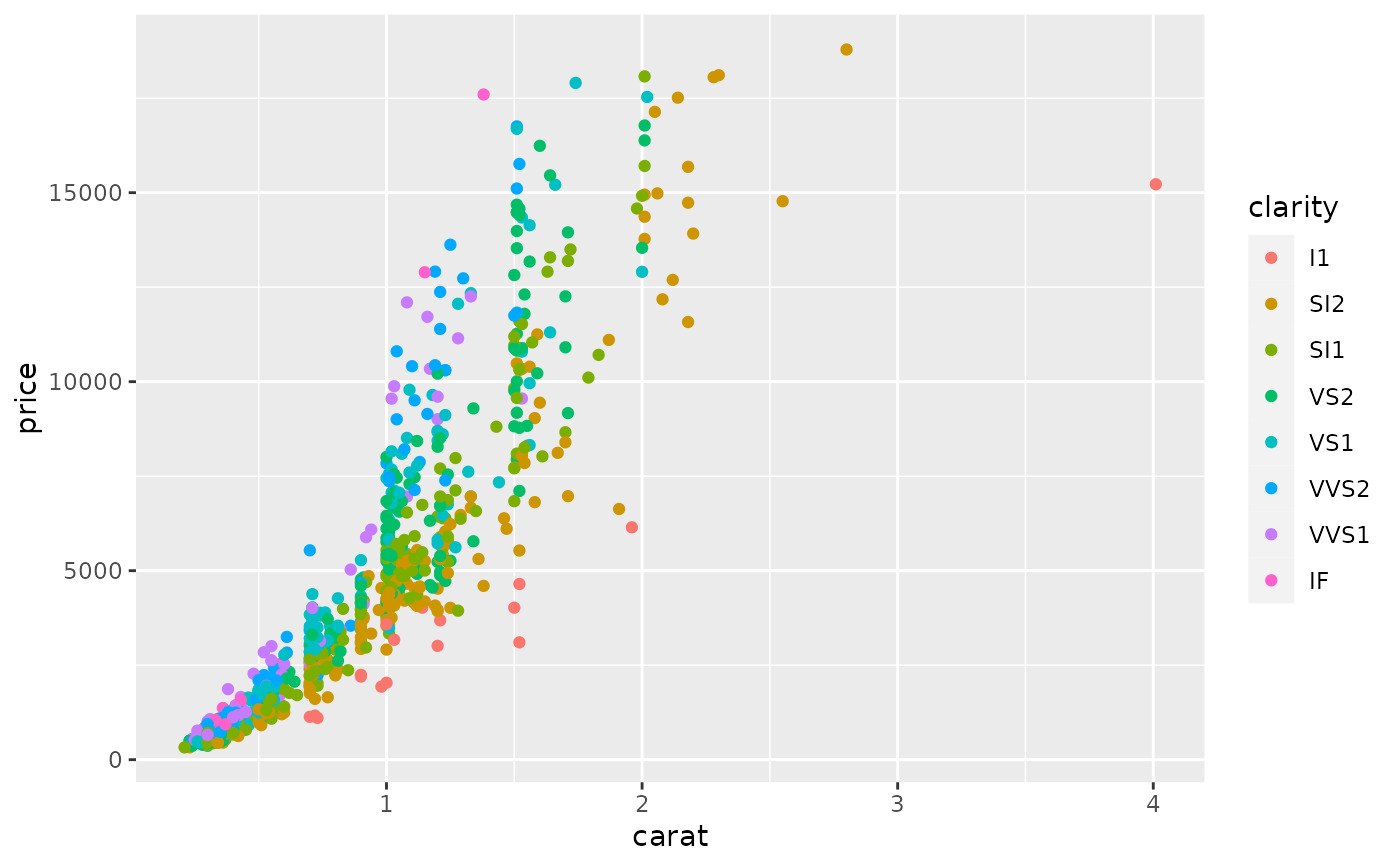 d + scale_colour_hue("clarity")
d + scale_colour_hue("clarity")
 d + scale_colour_hue(expression(clarity[beta]))
d + scale_colour_hue(expression(clarity[beta]))
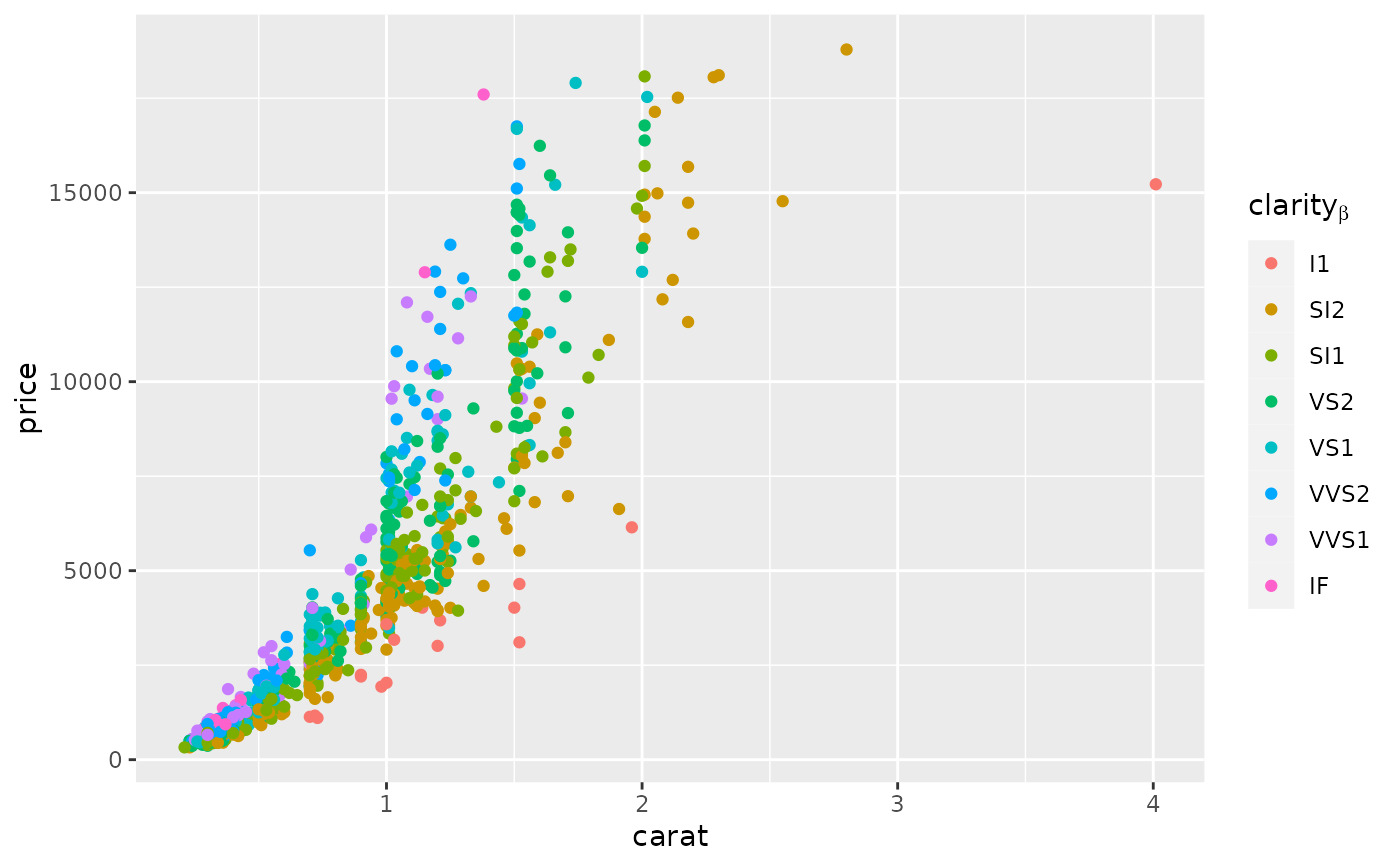 # Adjust luminosity and chroma
d + scale_colour_hue(l = 40, c = 30)
# Adjust luminosity and chroma
d + scale_colour_hue(l = 40, c = 30)
 d + scale_colour_hue(l = 70, c = 30)
d + scale_colour_hue(l = 70, c = 30)
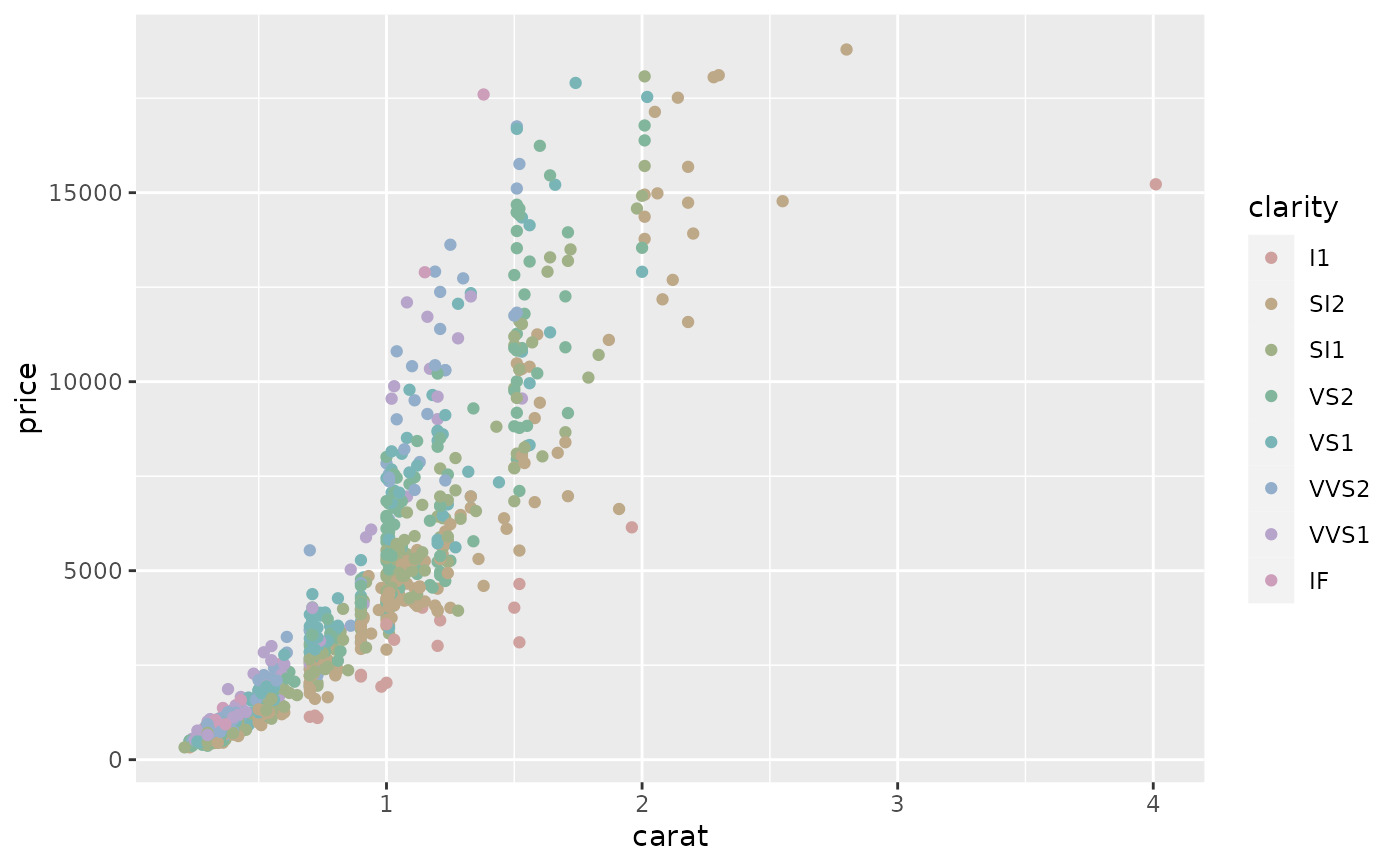 d + scale_colour_hue(l = 70, c = 150)
d + scale_colour_hue(l = 70, c = 150)
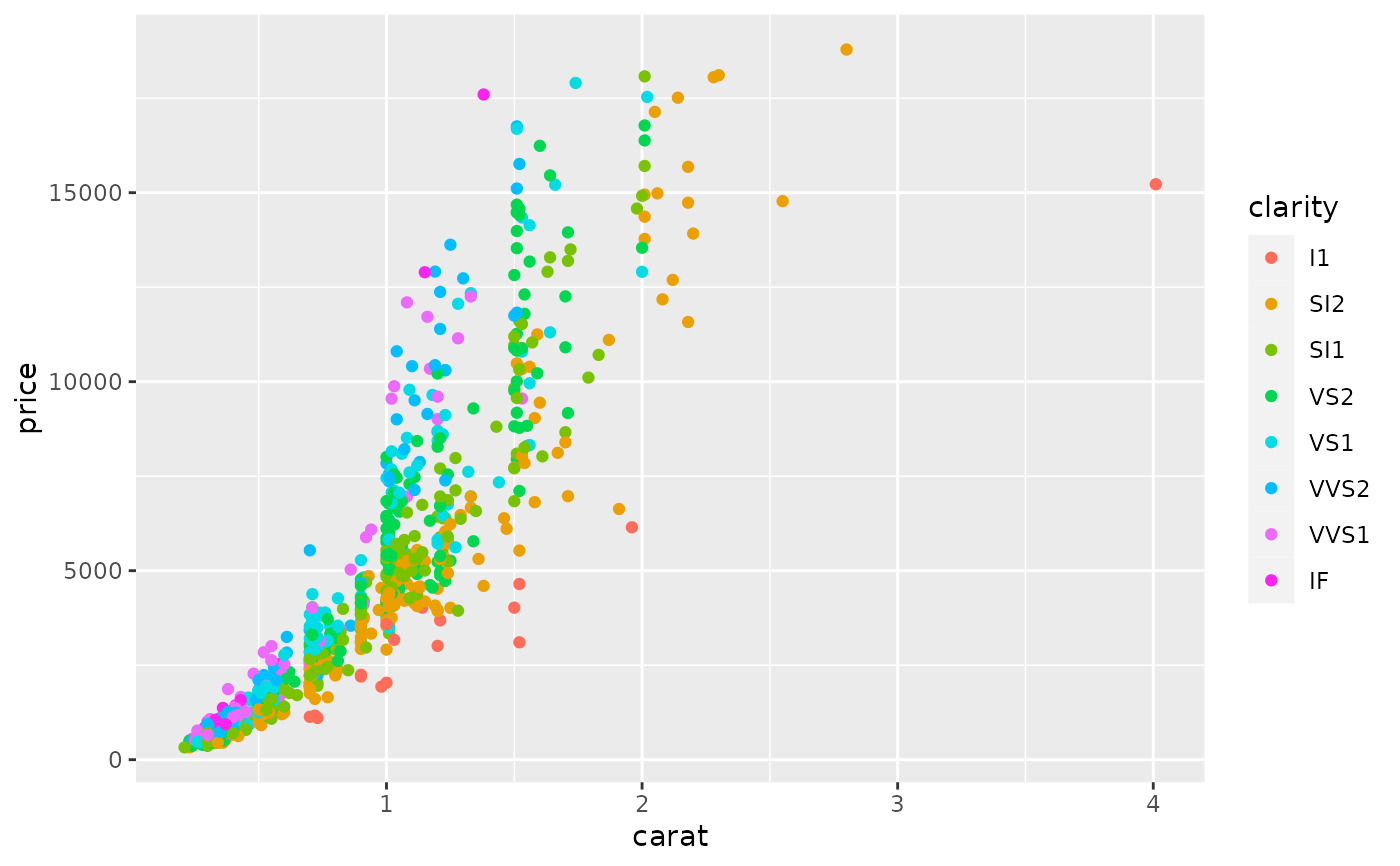 d + scale_colour_hue(l = 80, c = 150)
d + scale_colour_hue(l = 80, c = 150)
 # Change range of hues used
d + scale_colour_hue(h = c(0, 90))
# Change range of hues used
d + scale_colour_hue(h = c(0, 90))
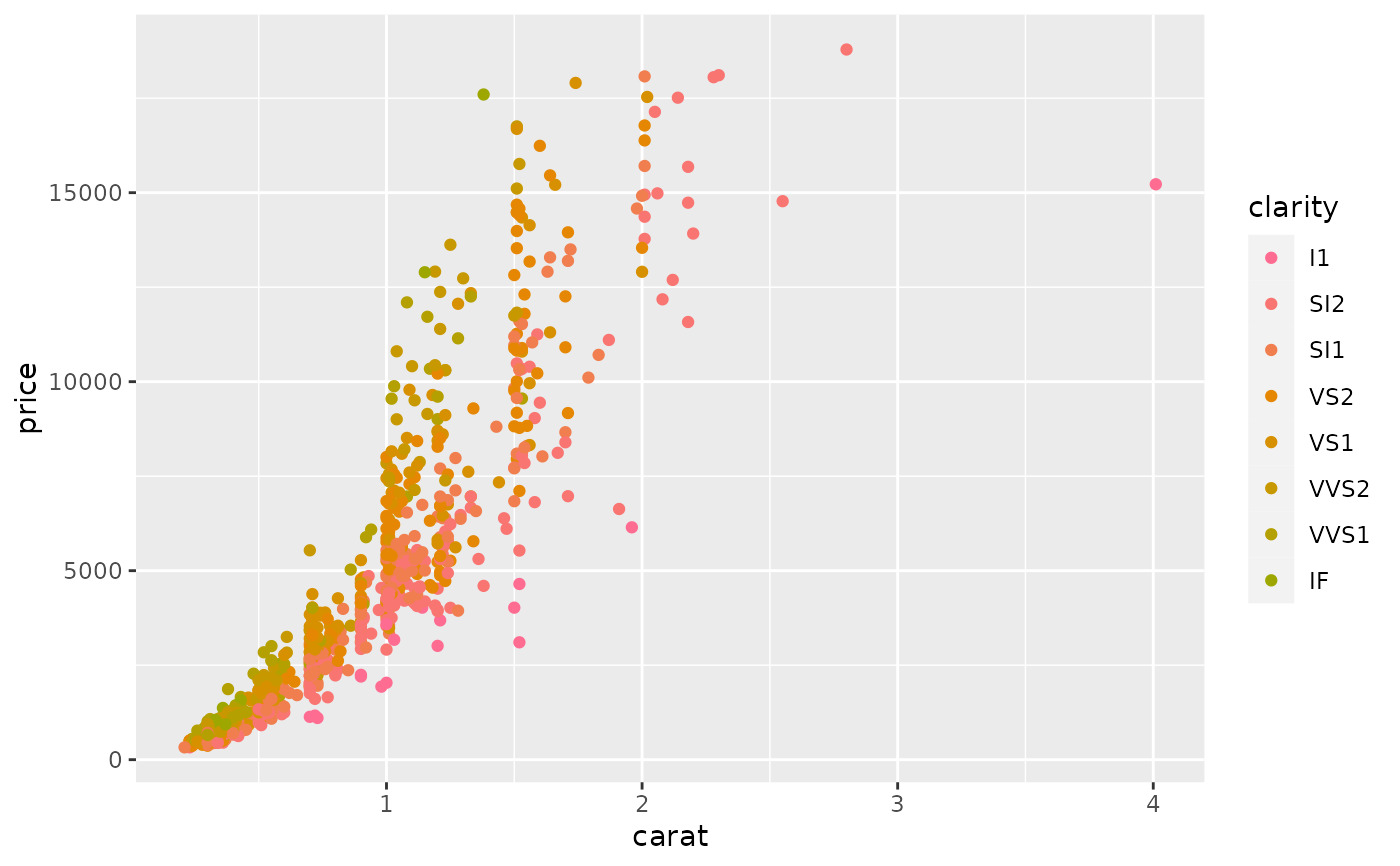 d + scale_colour_hue(h = c(90, 180))
d + scale_colour_hue(h = c(90, 180))
 d + scale_colour_hue(h = c(180, 270))
d + scale_colour_hue(h = c(180, 270))
 d + scale_colour_hue(h = c(270, 360))
d + scale_colour_hue(h = c(270, 360))
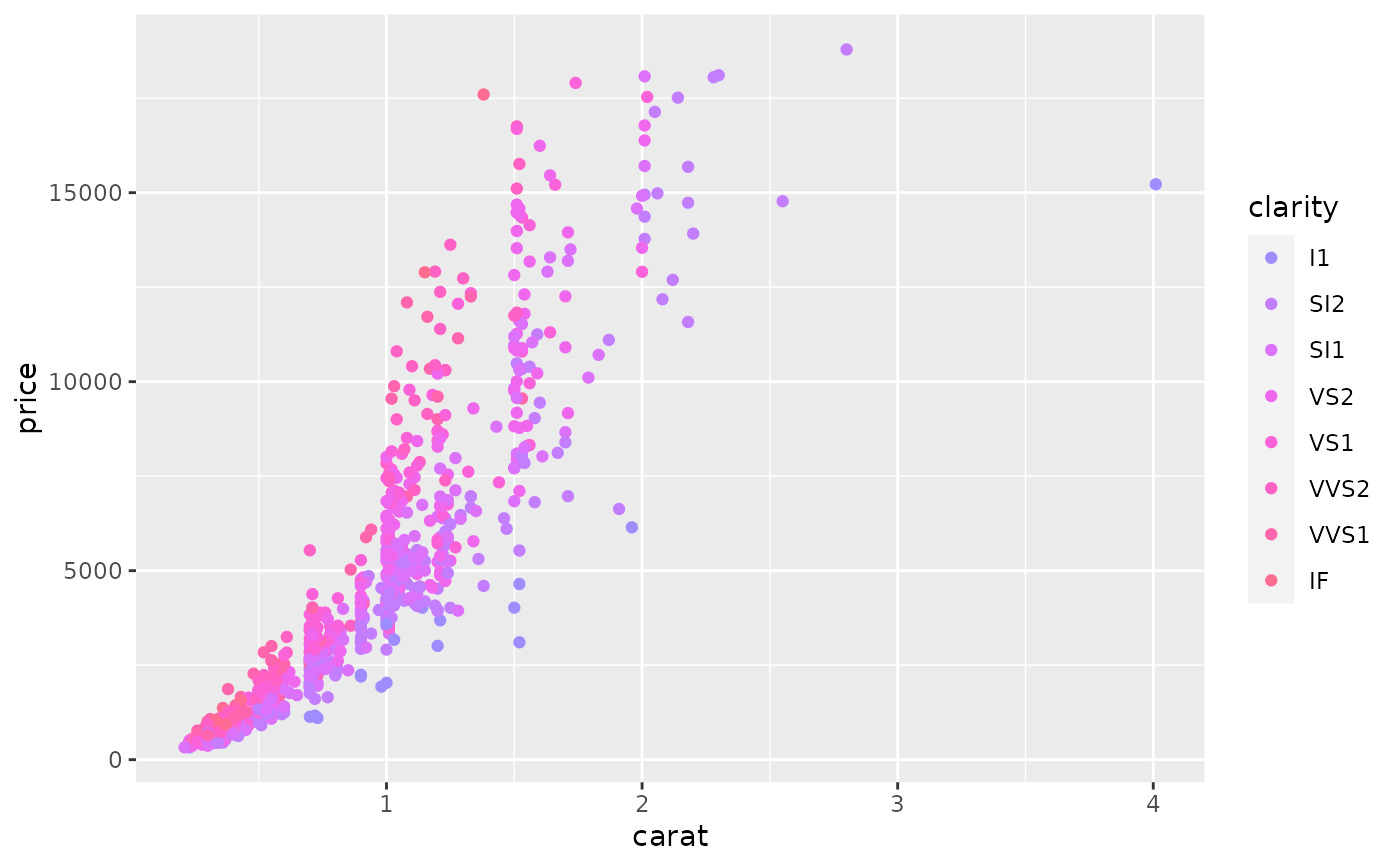 # Vary opacity
# (only works with pdf, quartz and cairo devices)
d <- ggplot(dsamp, aes(carat, price, colour = clarity))
d + geom_point(alpha = 0.9)
# Vary opacity
# (only works with pdf, quartz and cairo devices)
d <- ggplot(dsamp, aes(carat, price, colour = clarity))
d + geom_point(alpha = 0.9)
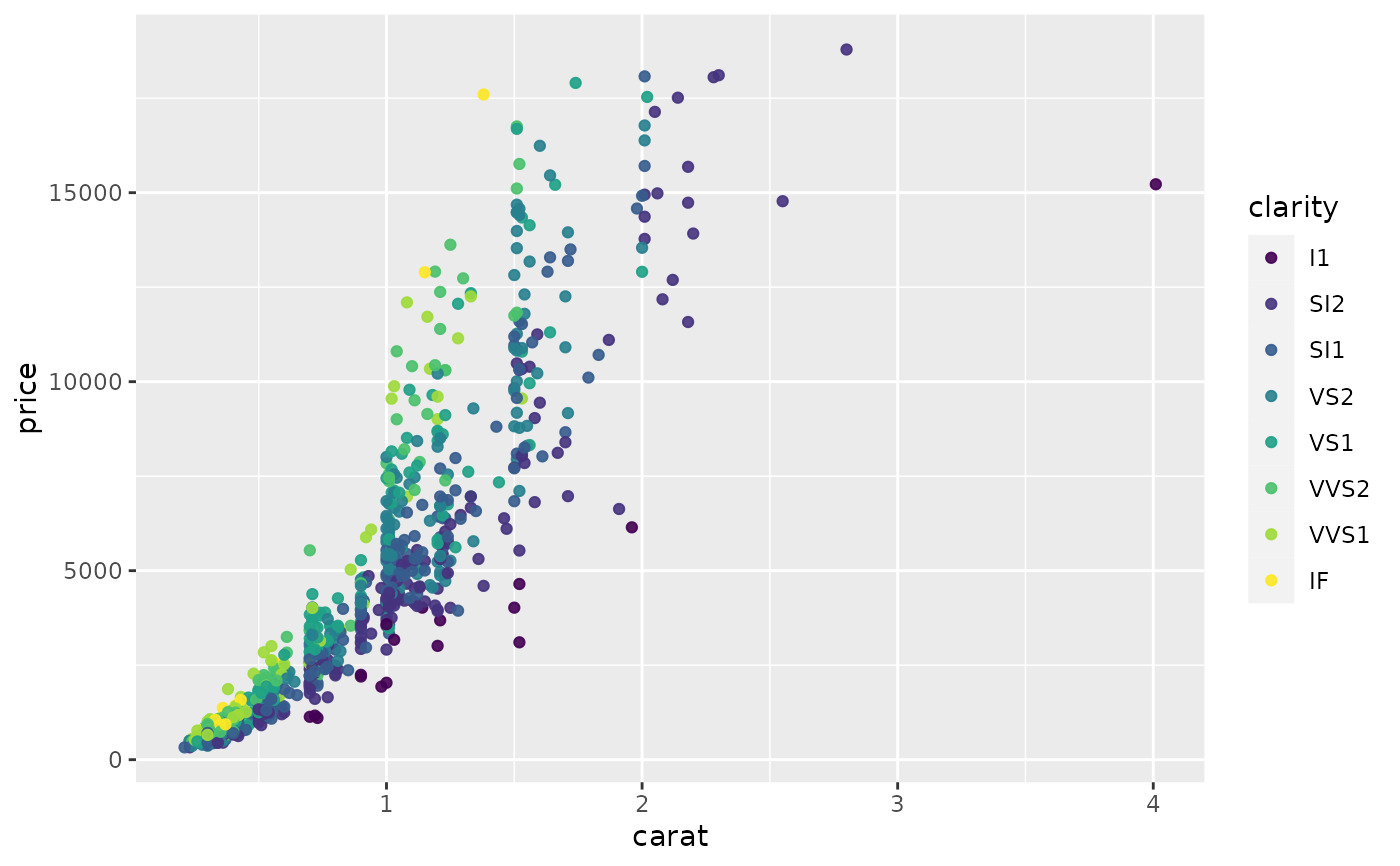 d + geom_point(alpha = 0.5)
d + geom_point(alpha = 0.5)
 d + geom_point(alpha = 0.2)
d + geom_point(alpha = 0.2)
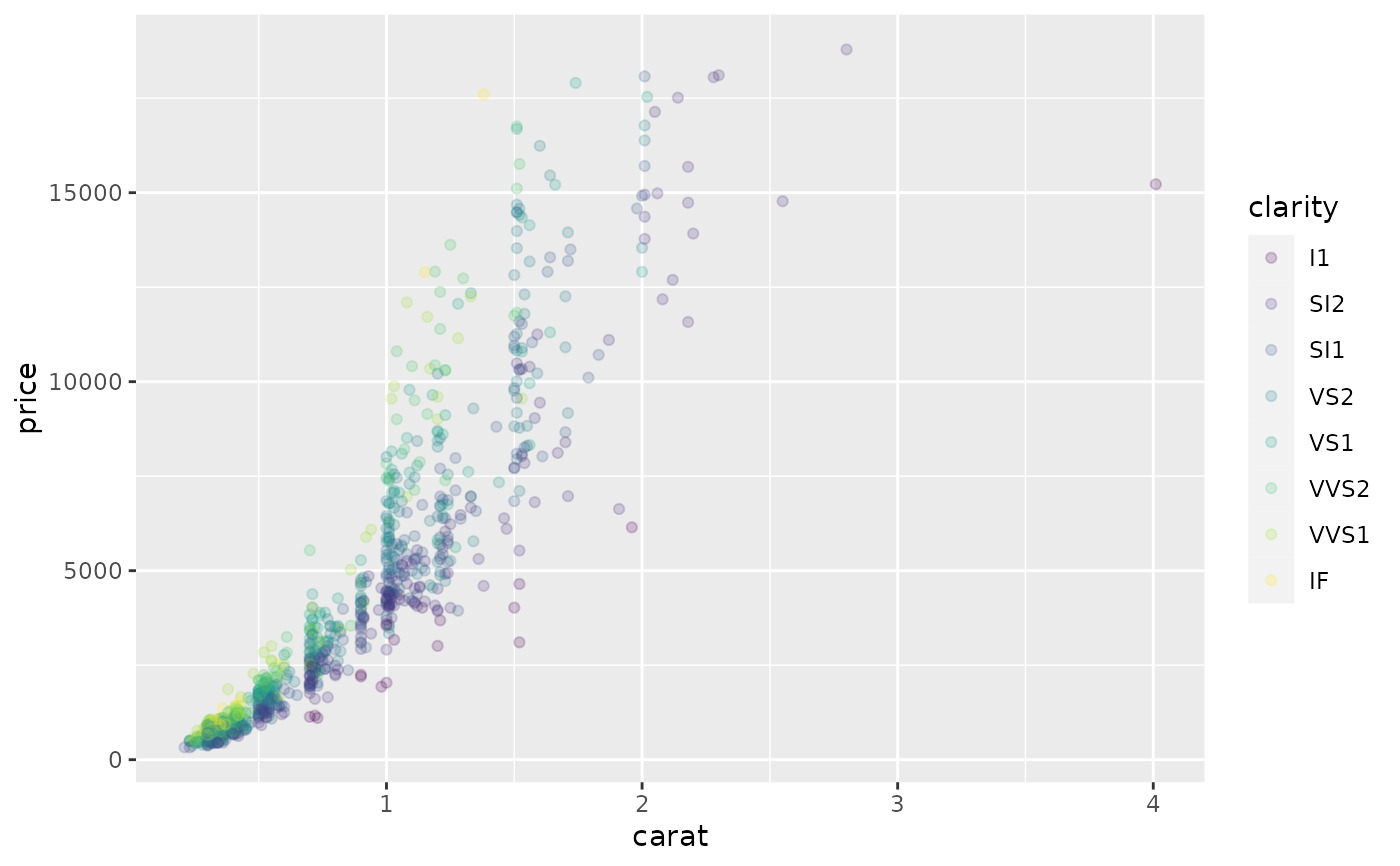 # Colour of missing values is controlled with na.value:
miss <- factor(sample(c(NA, 1:5), nrow(mtcars), replace = TRUE))
ggplot(mtcars, aes(mpg, wt)) +
geom_point(aes(colour = miss))
# Colour of missing values is controlled with na.value:
miss <- factor(sample(c(NA, 1:5), nrow(mtcars), replace = TRUE))
ggplot(mtcars, aes(mpg, wt)) +
geom_point(aes(colour = miss))
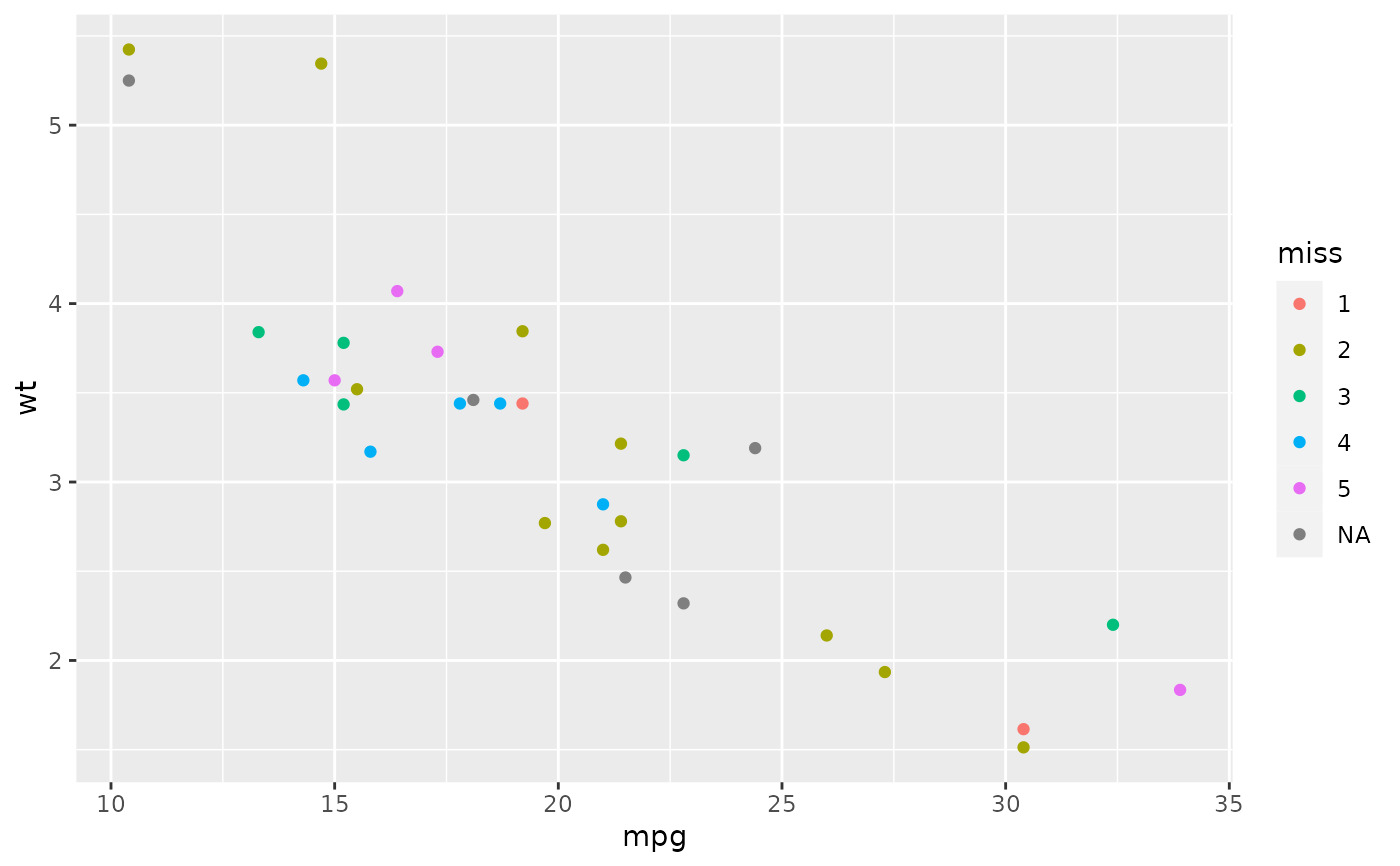 ggplot(mtcars, aes(mpg, wt)) +
geom_point(aes(colour = miss)) +
scale_colour_hue(na.value = "black")
ggplot(mtcars, aes(mpg, wt)) +
geom_point(aes(colour = miss)) +
scale_colour_hue(na.value = "black")
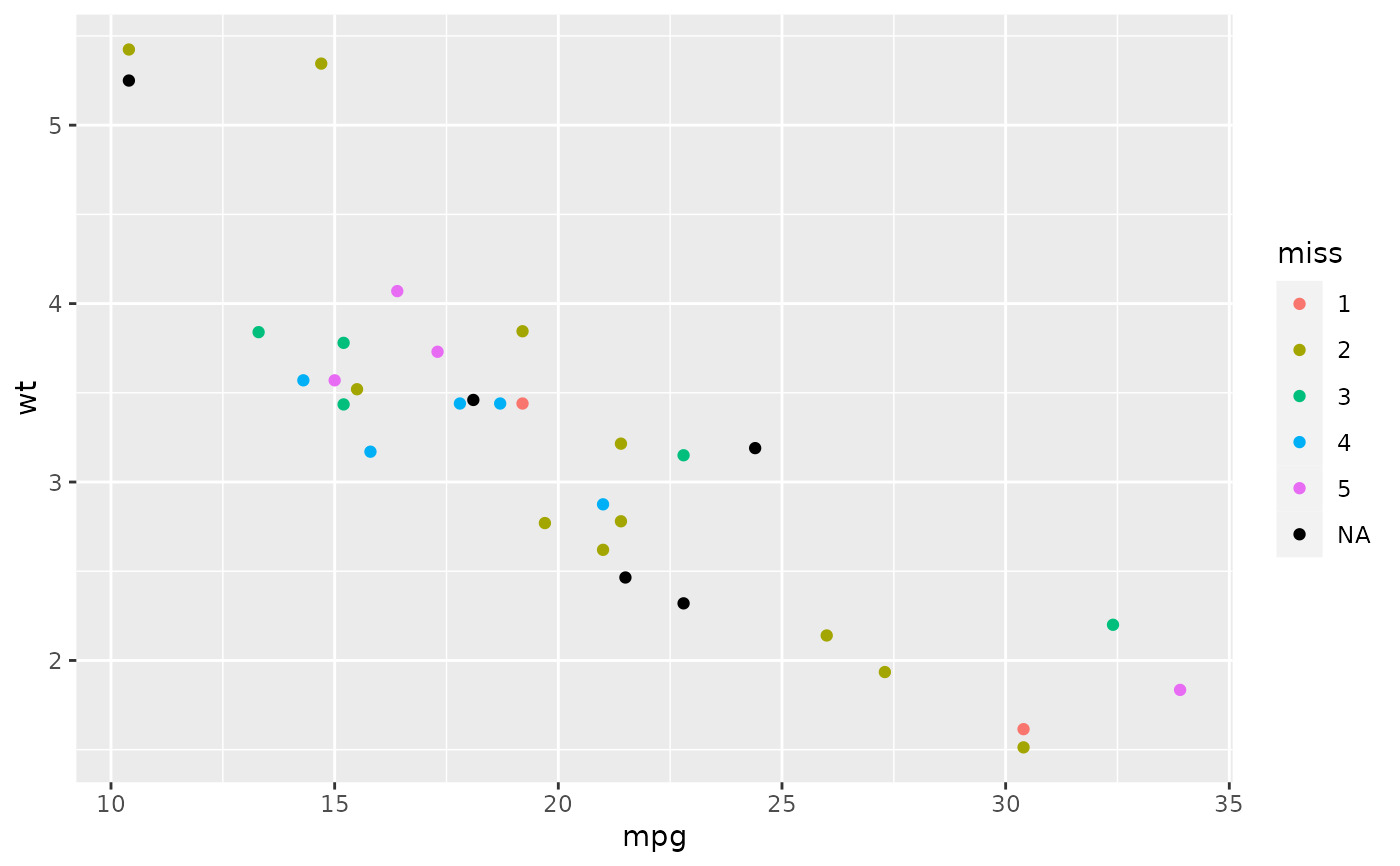 # }
# }
相關用法
- R ggplot2 scale_gradient 漸變色階
- R ggplot2 scale_shape 形狀比例,又稱字形
- R ggplot2 scale_viridis 來自 viridisLite 的 Viridis 色標
- R ggplot2 scale_grey 連續灰度色階
- R ggplot2 scale_linetype 線條圖案的比例
- R ggplot2 scale_discrete 離散數據的位置尺度
- R ggplot2 scale_manual 創建您自己的離散尺度
- R ggplot2 scale_colour_discrete 離散色階
- R ggplot2 scale_steps 分級漸變色標
- R ggplot2 scale_size 麵積或半徑比例
- R ggplot2 scale_date 日期/時間數據的位置刻度
- R ggplot2 scale_continuous 連續數據的位置比例(x 和 y)
- R ggplot2 scale_binned 用於對連續數據進行裝箱的位置比例(x 和 y)
- R ggplot2 scale_alpha Alpha 透明度比例
- R ggplot2 scale_colour_continuous 連續色標和分級色標
- R ggplot2 scale_identity 使用不縮放的值
- R ggplot2 scale_linewidth 線寬比例
- R ggplot2 scale_brewer ColorBrewer 的連續、發散和定性色標
- R ggplot2 stat_ellipse 計算法行數據橢圓
- R ggplot2 stat_identity 保留數據原樣
- R ggplot2 stat_summary_2d 以二維形式進行分類和匯總(矩形和六邊形)
- R ggplot2 should_stop 在示例中用於說明何時應該發生錯誤。
- R ggplot2 stat_summary 總結唯一/分箱 x 處的 y 值
- R ggplot2 stat_sf_coordinates 從“sf”對象中提取坐標
- R ggplot2 stat_unique 刪除重複項
注:本文由純淨天空篩選整理自Hadley Wickham等大神的英文原創作品 Evenly spaced colours for discrete data。非經特殊聲明,原始代碼版權歸原作者所有,本譯文未經允許或授權,請勿轉載或複製。
